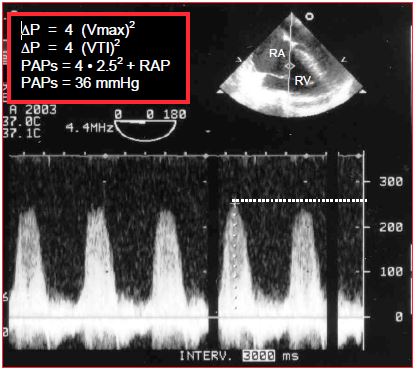A pulmonary catheter is not required for measuring PA pressure. A reliable estimate is possible using echocardiography, provided that the patient presents with tricuspid insufficiency (TI). This is physiologically present in over half of all normal individuals and occurs if right-sided pressure increases, i.e. in almost all patients with pulmonary hypertension. The maximum velocity of the systolic TI jet is dependent on the pressure gradient prevailing during systole between the RV and RA. The simplified Bernoulli equation establishes the relationship between velocity and pressure:
ΔP = 4 (Vmax)2
where ΔP is the pressure gradient between the RV and RA during systole, and Vmax the maximum TI velocity.
If there are no lesions in the right ventricular outflow tract or in the pulmonary valve, the systolic pressure of the RV equals the systolic pressure of the PA. RA pressure must be added to the value of the RV-RA gradient to calculate the value of PsystRV. It is estimated (mean value of 10 mmHg) or measured by CVP. This changes the equation as follows:
PAPsyst = 4 (Vmax TI)2 + RAP
In echocardiography, the Doppler beam is aligned with the TI jet and the computer automatically performs the calculation (Figure 15.7).

Figure 15.7: Echocardiographic calculation of systolic pulmonary pressure by the velocity of tricuspid insufficiency (TI). In the top right illustration, the Doppler beam is aligned with the TI jet through the tricuspid valve. The spectral display provides the maximum TI velocity, which in this case is 2.5 m/s. A simplified Bernoulli equation (ΔP = 4 V2) is used to calculate the prevailing pressure gradient (ΔP) between the RV and RA during systole by measuring the maximum velocity (V) of the TI. RA pressure (in this case 10 mmHg) must be added to this result (4 x 2.52 = 26 mmHg) to determine the pressure value in the RV during systole. In the absence of pulmonary stenosis or a VSD, this pressure is equal to systolic pulmonary arterial pressure (PAPsyst).
However, overall correlation between this calculation and direct measurement of PAPsyst by a Swan-Ganz pulmonary artery catheter is rather limited (r = 0.7) [3]. Among congenital heart disease patients, this calculation may be distorted by two situations [1]:
- Stenosis of the RV ejection pathway; RV APs is not equal to PAPsyst;
- Presence of a VSD; RV pressure is contaminated by LV pressure.
Pulmonary diastolic pressure is calculable if pulmonary insufficiency (PI) is present, which is almost always the case in the event of pulmonary hypertension. Since RAP and PdiastRV are equivalent due to the tricuspid valve being open during diastole, the following calculation is achieved by measuring the end-diastolic velocity (Ved) of the PI:
PAPdiast = 4 (Ved PI)2 + RAP
If a VSD is present, it is possible to calculate RV systolic pressure on the basis of the velocity of the blood flow in the L-to-R shunt. The maximum shunt velocity is used to measure the difference of pressure during systole between the LV and RV. The subtraction of Vmax VSD from systemic arterial pressure (assuming no aortic pathology) gives RV systolic pressure [2]:
PsystRV = APsyst - 4 (Vmax VSD)2
| Calculation of pulmonary pressure |
| On echocardiography: PAPsyst = 4 (Vmax TI)2 + RAP In the event of VSD: Psyst RV = APsyst - 4 (Vmax VSD)2 |
© BETTEX D, CHASSOT PG, January 2008, last update May 2018
References
- CHASSOT PG, BETTEX DA. Anesthesia and adult congenital heart disease. J Cardiothorac Vasc Anesth 2006; 20:414-37
- SILVERSIDES CK, DORE A, POIRIER N, et al. Canadian Cardiovascular Society 2009 Consensus Conference on the management of adults with congenital heart disease: Shunt lesions. Can J Cardiol 2010; 26:e70-e79
- THUNBERG CA, GAITAN BD, GREWAL A, et al. Pulmonary hypertension in patients undergoing cardiac surgery: pathophysiology, perioperative management and outcome. J Cardiothorac Vasc Anesth 2013; 27: 551-72
